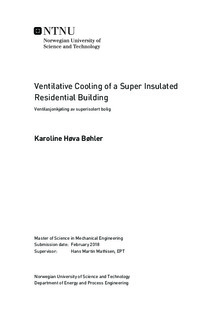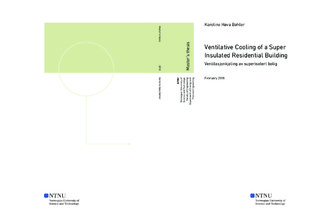| dc.description.abstract | Passive cooling methods are preferred for super insulated, energy efficient buildings, to keep the energy consumption low. However, well insulated buildings are associated with longer cooling seasons, which means that air with lower temperatures will be supplied to the buildings for certain periods. For these periods, the use of ventilative cooling is associated with thermal discomfort and draught problems. The objective of this master thesis is to establish a reliable tool, by using Computational Fluid Dynamics, that can be used to study cooling by window opening in super insulated buildings in cold climates. The CFD tool ANSYS Fluent will be used to establish a CFD model and carry out simulations, where the data from the simulations will be used for thermal comfort analysis.
The CFD model is based on the geometry of the ZEB Living Laboratory building facility, located in Trondheim, Norway. This is a research facility that was built with the purpose of investigating how users interact with low-energy buildings. The CFD model will be validated with full-scale experimental measurements.
Three models have been established in this master thesis. A set of simplifications to the model geometry and the simulation setup have been carried out, due to limitations in computer capacity and time restrictions. Model A verified the setup to simulate the mechanical ventilation system, and the appropriate boundary conditions for the walls and roof. Model B investigated the effect of solar load on the model and verified the setup of the solid surface material characteristics. The transient simulation with solar load revealed a risk of thermal discomfort due to overheating in the building. Model C carried out the simulations that are compared with the full-scale experiment measurements. Ventilative cooling with cross ventilation by 25% opening (of measured maximum) of the north window and 100% opening of a kitchen skylight window was investigated. Different boundary conditions were tested at the inlet of the north window opening. The compared results from the simulated cases and the experiment revealed that the CFD model is not yet able to predict the flow to an acceptable accuracy. The sources of errors are discussed and the ones that are presumed the most dominant are identified.
The data from the case that was concluded to predict the flow best, compared with the experiment, are used to explain how thermal comfort investigations with CFD solutions can be carried out. For the draught rate calculations, both the directional (attained form the simulation data) and the omnidirectional (calculated with correction formulas) values are considered, to investigate the turbulence effects of the flow. These are again compared with the full-scale experiment values. | |

